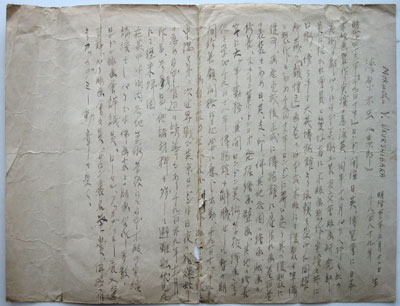|
|
| |
|
|
|
|
|
|
|

TRANSLATION OF PERSONAL HISTORY OF MOKUCHU (YOSHIJIRO) URUSHIBARA MOKUCHU Y. URUSHIBARA Travelled to England in 1910 (43rd Year of Meiji) for the purpose of putting on demonstrations of the processes involved in the production of Japanese woodcut prints at Anglo-Japanese Exhibition held in London in 1910. In December of the same year, he visited Paris, so-called “City of Art”, at the invitation of person(s) of the Woodcut Prints Research Department of the Japanese Arts and Crafts Friendship Exchange Association (1), to demonstrate and explain verbally to the members of the association and other enthusiasts the production processes of woodcut prints; along with this, he commenced the preparations for the production of a reproduction of a scroll of pictures by “Gu Kaizhi (Ku K’ai-Chih)” in the possession of the British Museum under a commission that had been received earlier from the museum. He then returned to London in 1912 and engaged in the production of the reproduction of said scroll of pictures; following the completion thereof [sample image], he was officially hired by the museum and served there for six years during which time he engaged in the mounting of 100 picture scrolls and also the restoration of pictures and woodcut prints of Japan, England, China, India, France and other nations and the restoration of pictures and murals from the Tonko excavations in the Aurel Stein Collection (2), during which period he studied drawing/painting at the London Art School (3). He resigned from the museum in 1918 but continued to serve at the museum for a while in the capacity of a restoration adviser. Since 1918, he collaborated with the artist, Brangwyn, in the production of Brangwyn’s works and also produced his own original woodcut prints, but while engaged in this work, because London, the capital of England, was being subjected daily to German bombing because of World War II, along with guidance from the Japanese authorities, he evacuated from England in November, 1939 (4), leaving behind his works, reference material and other material. During his stay in England, he conducted demonstrations and lectures on Japanese woodcut prints at art teaching establishments throughout the nation, while in Paris, he produced many woodcut prints in collaboration with French artists; he was a member of the council of the London Woodcut Prints, many of his works won awards at the Royal Academy, he was a member of the Paris Woodcut Print Association, he received an honorary award from the Salon Exhibition, and he was awarded the title of Officier d’Academie from the French Government. Translator's Notes:
|
|
|
| |
|
|
| |
|
|
| |
|
|
| |
|
|
|